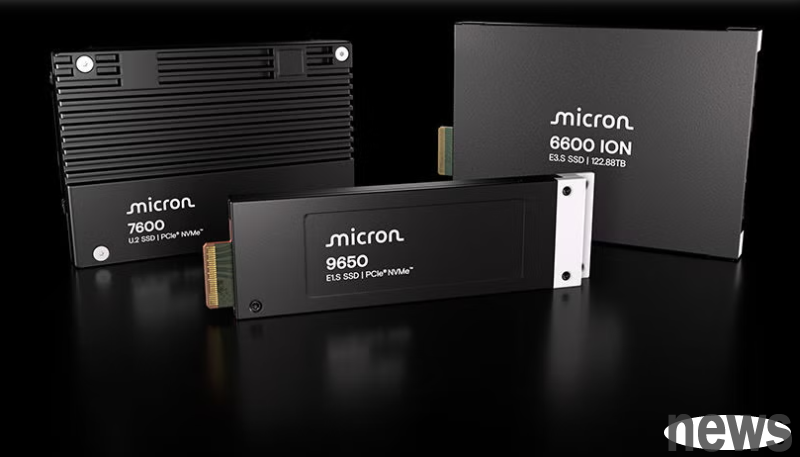
The world is entering a new era driven by artificial intelligence (AI), and the demand for large data storage is growing explosively. This trend is profoundly changing the basic facilities of data centers, especially as enterprise-level solid-state hard drives (SSDs) accelerate the replacement of traditional hard drives (HDDs) and become the core storage solution for AI material centers. Industry predicts that QLC NAND Flash will face a severe shortage of supply for large data storage.
Market news pointed out that many American cloud service providers (CSPs) are actively promoting large-scale plans with the goal of replacing the HDD used in their data centers with SSDs around 2026. According to the latest research by TrendForce, a market survey agency, also stated that the large amount of data created by AI is impacting the global data center storage facilities. Nearline HDDs, which are traditionally based on massive data storage, have shown supply shortages, which has prompted high-efficiency and high-cost SSDs to gradually become the focus of the market, especially the large-capacity QLC SSD shipment may experience explosive growth in 2026.
This transformation is not a hole, because as AI training and recommendation servers are increasingly demanding on storage device performance, traditional HDD or TLC NAND has been unable to meet demand, driving NAND manufacturers to transfer larger proportions of production capacity to QLC SSDs. In addition, global cloud service operators achieved a record high in revenue, including Google and Micro, and other technology manufacturers, which have vigorously expanded AI infrastructure and turned to high-efficiency recommended applications, driving the market to significantly increase demand for large-capacity storage products. Industry insiders pointed out that the delivery time for large-capacity HDDs has been scheduled for almost a year, so memory operators have also greatly improved the development of Nearline SSD products, hoping to reduce the price difference between them and HDD from the current 4 to 5 times to about 3 times to improve customer input.
For cloud manufacturers' large-scale purchases of enterprise-level SSDs, the market estimates are that this situation comes from the AI training stage, the storage configuration of SSDs has been increased from 4TB to 8TB. As for the AI recommendation stage, with storage capacity increasing from 64TB to up to 122TB, SSD has become an indispensable core storage device for AI training and reasoning servers. As for, the original traditional HDDs have also encountered continuous situations in the market due to increased demand. Recently, major suppliers such as SanDisk and Vitex Electronics (WD) have launched their first guns and started preparing for price increases. This is a rare situation in recent years to meet the rapid growth demand for storage products in the AI era. Among them, Viteng Electronics also stated in a statement letter to customers a few days ago that in order to increase the use of sea transportation to reduce carbon emissions, the transportation time of HDD products may increase by about 6 to 10 weeks, which will lead to a longer delivery time, which will impact the current supply of HDD market.
Look back, although the advantages of SSD are about 10 times that of HDD in terms of data access speed, it can meet the speed requirements for large amounts of reading during AI computing. However, HDDs have always had low unit storage capacity, making them high in price, which is enough to handle jobs including backup or near-line storage. In addition, in the past, QLC NAND had a limited acceptance in the enterprise market due to its low durability and written life. However, with the advancement of NAND Flash process and the upgrading of SSD control chip technology, the effectiveness and life of QLC SSD have been greatly improved. For example, the latest PCIe 5.0 SSD has significantly improved the reading performance of QLC SSDs through improved controllers and cache technology, making them more suitable for enterprise applications. Current-level enterprise-level QLC SSD has grown to 128TB capacity. In addition, the cost cost has been greatly reduced, resulting in a narrowing of the price difference between QLC NAND and HDD, resulting in the interest of CSP large manufacturers that are actively introduced and are expected to gradually replace HDD's position in the large data storage field in the future.
Recently, the US foreign exchange release report issued a 45-page report pointing out that it is positively viewing NAND industries and expects that 2026 will be the "turning point" of NAND industries, and that the industry will enter a structural balance. The report mentioned that considering the continued growth of AI recommendation demand, it is expected that in the basic situation, a 2% gap will appear in NAND supply, while in the happy situation, the gap may even reach 8%. Currently, QLC NAND's supply capacity accounts for the entire NAND market is still relatively limited, including Micron and SK Hynix's Solidigm that makes major suppliers. As for, the memory dragon Samsung accounts for a limited proportion in the QLC NAND market.
It is worth mentioning that Taiwanese memory module manufacturers are expected to benefit from this new wave of AI storage. For example, Qunlian Electronics is the world's leading SSD control chip supplier. It has cooperated with Viagra and Micron to promote enterprise-level QLC SSDs and continue to develop PCIe 5.0 controllers. Viagra has also greatly expanded QLC SSD-related product lines, covering consumer and enterprise markets. Azhan Technology focuses on industrial and enterprise QLC SSDs, locking high-performance computing (HPC) and AI applications. In the future, the new NL SSD (between traditional HDD and eSSD, focusing on high capacity and relatively low cost) may also become an alternative to HDD from 2026 to 2027.